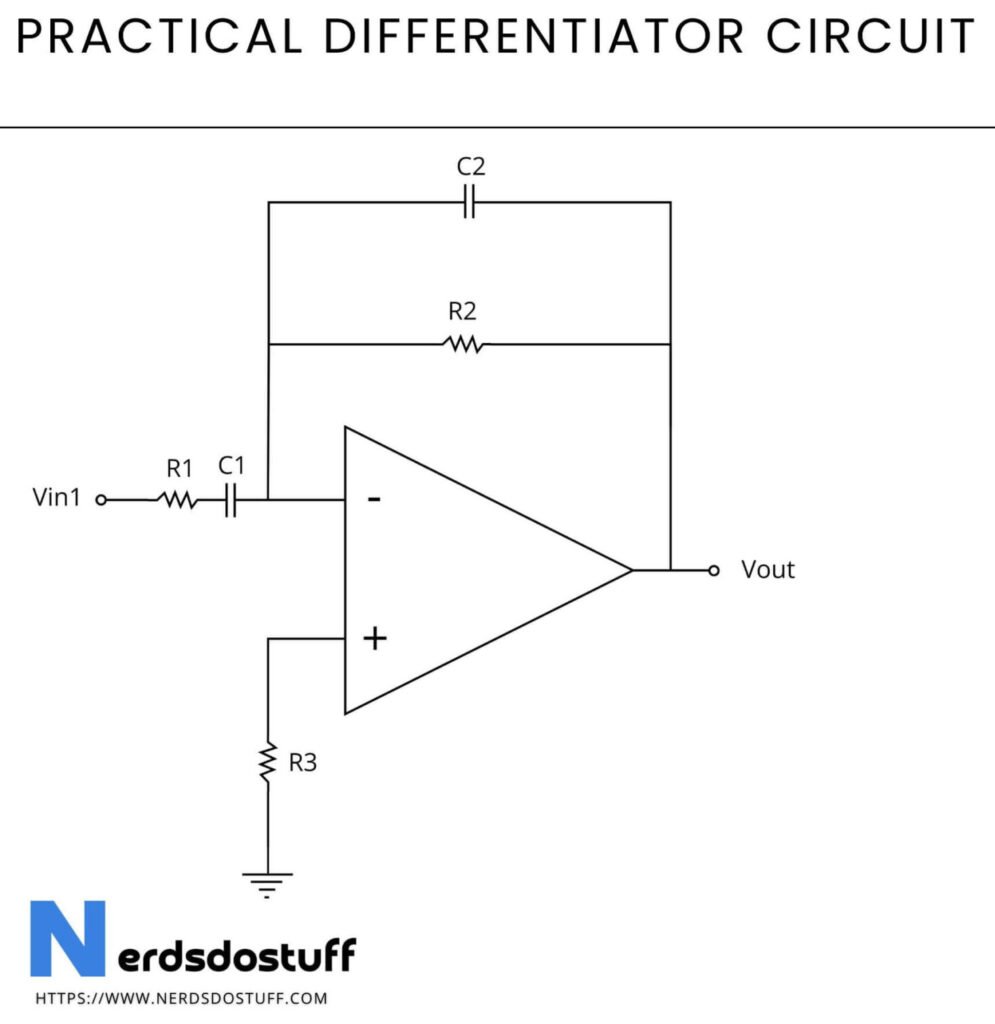What is Practical Differentiator ?
A practical differentiator is an electronic circuit that performs the mathematical operation of differentiation on an input signal with respect to time. It typically consists of an operational amplifier (op-amp) configured as a non-inverting amplifier with a capacitor in the feedback loop and a resistor connected to the input. As the input signal changes, the capacitor reacts by allowing the rate of change of the input voltage to pass through, resulting in an output voltage that is proportional to the rate of change (or derivative) of the input signal. This configuration effectively differentiates the input signal, emphasizing rapid changes or high-frequency components while attenuating low-frequency components.
Practical Differentiator Circuit

Working of Practical Differentiator
A practical differentiator operates by accentuating the high-frequency components or rapid changes in an input signal while attenuating the low-frequency components. It consists of an operational amplifier (op-amp) configured as a non-inverting amplifier with a capacitor in the feedback loop and a resistor connected to the input. As the input signal varies, the capacitor reacts to rapid changes by allowing the rate of change of the input voltage to pass through, while blocking the DC or low-frequency components. The output voltage of the differentiator is thus proportional to the rate of change (or derivative) of the input signal with respect to time. By adjusting the values of the resistor and capacitor, the differentiator’s frequency response and sensitivity to changes in the input signal can be controlled.
Characteristics of Practical Differentiator
| Characteristic | Description |
|---|---|
| Configuration | Typically consists of an operational amplifier (op-amp) configured as a non-inverting amplifier with a capacitor in the feedback loop and a resistor connected to the input. |
| Differentiation | Performs the mathematical operation of differentiation on an input signal with respect to time, emphasizing rapid changes or high-frequency components while attenuating low-frequency components. |
| Output Response | The output voltage is proportional to the rate of change (or derivative) of the input signal with respect to time. |
| Frequency Response | The differentiator’s frequency response is determined by the time constant of the circuit, which is determined by the values of the resistor and capacitor. |
| Sensitivity | By adjusting the values of the resistor and capacitor, the sensitivity of the differentiator to changes in the input signal can be controlled. |
| Applications | Widely used in electronic systems for applications such as edge detection, differentiation of transient signals, frequency analysis, and signal processing. |
Applications of Practical Differentiator
- Edge Detection: Practical differentiators are widely used in image processing and computer vision applications for detecting edges in images. They emphasize rapid changes in pixel intensity, helping to identify boundaries between objects or regions within an image.
- Transient Analysis: Differentiators are used in transient analysis applications to analyze and characterize the behavior of signals during transient events, such as spikes, pulses, or glitches. They help in identifying the timing and duration of transient signals in electronic circuits or systems.
- Frequency Analysis: Differentiators are employed in frequency analysis applications to extract high-frequency components from input signals. They are useful for detecting and analyzing the presence of specific frequency components or harmonics in a signal.
- Signal Processing: Differentiators are used in signal processing circuits to perform tasks such as differentiation, edge detection, and feature extraction. They help in enhancing certain features or characteristics of a signal while suppressing others, enabling more effective signal analysis and processing.
- Sensor Signal Conditioning: Differentiators are used in sensor signal conditioning circuits to process signals from sensors that produce rapidly changing outputs in response to changes in physical quantities, such as acceleration, velocity, or pressure. They help in extracting relevant information from sensor signals while filtering out noise or interference.
- Communication Systems: Differentiators are employed in communication systems for tasks such as pulse shaping, modulation, and demodulation. They help in shaping the transmitted signals to meet specific communication requirements or in extracting information from modulated signals.




